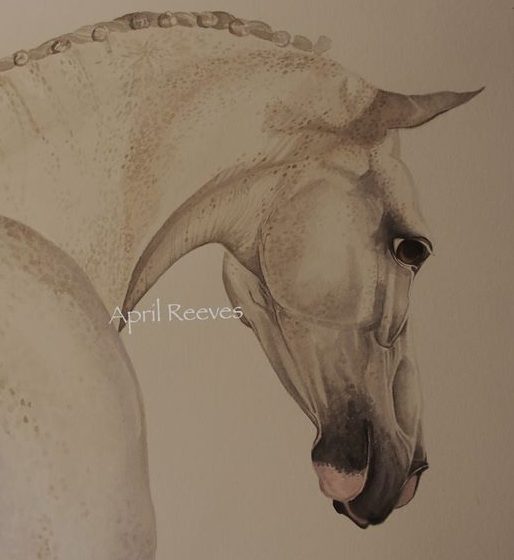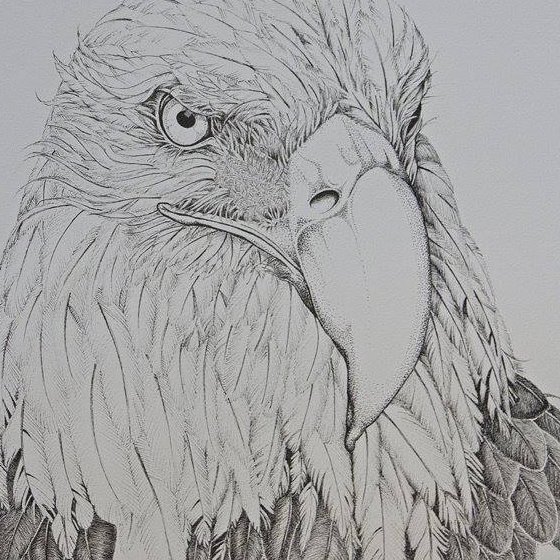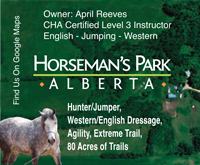
Horses need to learn balance and lateral flexion for slower gaits
Question: I was wondering if you had any tips for me concerning my horse. I have a very typey and sensible 7 yr old QH mare. I would love to do lower level western pleasure with her! Her jog is amazing, she keeps her head perfect and has a very slow legged, reachy, consistant jog. Her lope is very different. She is very quick, but I can get about 4 slow loose reined strides, then she speeds back up and she’s flying. I believe this has to do with the girl that was riding her before I did. She wasn’t a very experienced or strong rider, and let her just do whatever. Any tips?
Answer from April Reeves: When horses speed up at the canter it’s usually a sign they are moving flat without enough spring and too heavy on the forehand. While you are enjoying a slow jog, it may be one of the causes of your problem as horses often lower their heads and move slowly without any form of collection, engagement or spring. While they are able to move slow at the jog, the canter propels them forward into a more suspended gait, and in order to sustain a canter they have to pick up speed.

An exaggerated photo showing the horse's build running downhill
Often conformation plays a role in the canter. If the horse is built “running downhill” it will be a struggle to get the horse off it’s front end and place that weight back. Leg conformation plays another key role in natural slow movement. When you look at your horse from the side, standing squarely on all 4 legs, take a straight edge and standing back about 10 feet, hold the straight edge out and line it up with the top of the knees and back hocks. If the horse’s hocks and knees are pretty much at the same height, and your straight edge is horizontal, chances are you will have an easier time getting the horse to balance. If the back hocks are higher, the horse will always be pushing itself forward onto the front legs.
Another cause is possibly your balance during the canter. Let’s go through what you do during the canter and work on perfecting that first.

This incredible weanling is well balanced both in body and legs
When you begin the aids for the canter, make sure your body is not leaning in the direction you want to go. This puts additional weight on the leading leg and hinders the movement. Also, where are your eyes going? Many riders look down too much. Get into the habit of looking forward. Horses travel where their riders are looking.
As you ask for the canter depart, keep a bit of your weight on the opposite seat bone, and free up your leg on the leading side. To ready your horse for the right lead, keep your back straight, put a bit more weight on the left pelvic bone, take your right leg and bring it slightly up and away from the horse, use your left leg back ( I use a quick swish movement as opposed to a long drawn out pressure. It’s more distinct to the horse and the constant pressure can numb a horse to the aid) and ask.
As the horse picks up the lead, stay centered. Be very mindful of whether you lean side to side or forward. When I canter, I work at staying very quiet in the saddle. I find this helps just as much as any riding technique (half halts, connection work). I tend to ride slightly behind the motion of a fast canter, making it more comfortable for the horse to go slower and less comfortable going faster. Your seat can control a great deal of speed and movement, so work on obtaining a solid seat with feeling.
Now that we have ruled out any problem on your end, let’s deal with the training of this horse to slow down.
Canter Circles
If you want to canter well, do a lot of canter work. I have my horses canter early in the lesson when they are fresh but warmed up. Many people take too long to canter and end up with a tired horse that doesn’t canter well, so the rider quits too early. I find horses that canter fresh learn to pace themselves and naturally find a slower rhythm.
One exercise I really like is the descending/ascending circle. Start your canter in a fairly large circle. Each time you make one revolution, decrease the size one foot, until you are in a size that’s just starting to get too small and uncomfortable for the horse, then increase the circle by one foot per revolution until you are back to your original size. I often do this over and over with young horses until they gain confidence as their balance improves.
Counter Canter
This exercise is one of the best to get a horse to use his back end and balance. Begin a large circle on the correct lead, and through a figure 8, change direction without changing leads. Keep the ‘wrong’ lead through the turn and up the long side of the arena. Then move back through the figure 8 and back to the correct lead direction. Repeat. Do this exercise every day and at 30 days your horse will show a dramatic improvement in balance. This is one of my favorites. It also teaches obedience. Do not let the horse break gait. At the beginning, start with only a few counter circles and add as the horse gains muscle.
Teaching Rhythm, Pace and Responsibility for Gaits
This next exercise will teach your horse to take responsibility for her gait. You should never have to constantly push a horse every few strides, nor should you have to try to correct a fast horse all the time. Horses should stay in the gait you ask until you ask otherwise, and this exercise will help. It’s also easy. You will do very little. There is no direct pulling on the face or aggressive motion on your part.
You will need a large area like an arena or field where you can ride safely, as your horse will be moving fairly fast. Begin by asking the horse to canter, keeping her in a series of circles. Keep the circles fairly large, as you don’t want to put stress on the legs and muscles. Keep your reins loose and allow your horse to canter freely.
Let the horse canter as fast or as slow as she wants, and gently guide her to stay in the circle, asking her head to follow the feel of the rein. Do not pull or try to change her speed. Just stay there and go for the ride, quietly, keeping your legs off the horse.
Do not try to change the speed of the gait you are in, or manage it in any way. Always remember what the single lesson is.
Your only job is to make sure she does not change her gait: she is to keep cantering. If she slows down and almost breaks into a trot, bring her up to a canter again very quickly.
I like this exercise because it really takes the speed out of a horse fast. I have a saying, “I can ride longer than you can run”, and if I’m on a speedy horse, they had better run past the point where they want to quit. The minute they begin to settle and slow down, I ask them to take it back up into a fast canter again, and when they are in the faster canter, I make it my idea to slow down. I have never seen a horse yet that didn’t take me up on the offer.
Never Wind a Horse
One thing I never do when cantering is wind a horse. I train all my horses all the same by giving them a good long walk until they are breathing normally again before I ask them to work again. That way they stay fresh and happy. A sour horse won’t work for you. Once a horse begins to breathe too hard I shut it down and walk, then pick the lesson back up.
Lateral Flexion
There are many lateral flexion exercises that help to supple the body and gain balance in all gaits.
Leg Yield/Hindquarter Exercise for Lateral Flexion
This exercise develops the hindquarter reach under the horse’s bellybutton. In order for a horse to balance upright in the gaits, they must bring their back legs under and in the center of their footfall pathway. By nature, a horse leans the opposite way of going, and often uses the back legs in a box pattern for moving quickly and balance. Now we come along and ask that box to change into an upside down triangle. While this is not easy at first for the horse (as they can fall over if they do not balance properly), they will need to learn this in order to stay upright and perform the tasks and movements we ask. The horse needs the time and experience of this new way of moving in order to gain confidence. This exercise also serves as a leg yield to ask the hindquarters to move away from the pressure.
As you walk, bring one rein up behind the wither towards your opposite shoulder without crossing the withers. The horse’s head should be fairly close to your knee, within a foot or more. Use your inside leg to yield the hindquarter over and the back legs to cross over. Ask for only one cross over step at a time, and gradually build on that until the horse swings the hindquarters away with ease and a soft aid. Switch sides each time. Allow the horse to walk 2-3 straight strides before picking up the other side.
You can never do enough of lateral exercises. I use them before, in the middle and at the end of every ride. Just as a jogger would stretch before and after a run, so must your horse.
You will find that this exercise helps release the poll once your horse becomes supple and stretched. It’s in this poll softening that you will find vertical flexion – where the horse gives at the jaw and poll.
Transitions
I ask a horse to perform a great deal of transitions during a single ride. I don’t think I have ever traveled around the whole arena on the rail unless I’m working on western pleasure. Up and down transitions help to balance the horse and get him thinking about being prepared by having his hindquarters underneath him so that when I ask he’s ready. Transitions also elevate the horse and keep them obedient.
Skip-A-Gait
Work on missing a gait in your up and down transitions, for example, the walk to the canter, the halt to the trot – canter to walk, trot to halt. When you do this, do NOT get any of the ‘missing’ gait such as little trot steps in the middle of the walk to canter to walk. All the gaits must be clean. Do this in circles and straight lines.
Start by traveling on the circle in one full diameter, then change into the next gait. As your horse gets better, skip your gaits in a shorter sequence until you can skip from 3 steps of each gait. If the horse begins to anticipate, change direction and ask for lateral flexion work.
This is a more advanced exercise and one that you could work on as your horse begins to slow down and ‘lift’ a bit more.
Collecting Half Halts
This is a very advanced exercise but I threw it in so that you could keep it in the back of your mind once your horse begins to slow down. Much like connection work, collection work consists of single leg/hand pressure to ask the horse to collect the frame and shorten it. As the horse shortens, the gait will slow down because the legs will not be traveling as long in the stride. Instead, they will lift, especially the back legs (engagement), which brings the hindquarters lower. You should not lose your rhythm in shortening or you are not collecting properly.
As you trot and canter, add rein and leg pressure (closure of seat, hand and leg) in one single, short flowing motion (not stiff and mechanical) to shorten the stride. At first the horse will not be really responsive, but in time as the horse develops strength they are more capable to sit back and raise the front. Apply the pressure at every 4-6 strides, and shorten to every third stride once the horse begins to gain muscle and memory for the exercise. Only use enough pressure to get a response. As the horse increases it’s ability, soften these aids.
One trick to timing with half halts is to ask the horse to ‘collect’ while the legs are in the air at the canter. This allows the horse to bring the back up and shorten the stride easier.
If you start this exercise at the trot you will find that it transfers to the canter. If a horse learns it in one gait, they will find it easier to remember it in another gait. The canter will be more difficult for the horse to collect in, for the fact that it takes more muscle and balance, but the aids will be recognizable.
Lengthening and Shortening the Stride
Come down the long side of the arena, or across the diagonal. Close both legs on the horse and ask for a lengthening of the legs (not a quicker stride), keeping rhythm and cadence. Do not give the horse’s face away. Keep your outside rein in good contact, with soft elastic elbows and a straight line from bit to elbow. Keep your hands upright, thumbs up. You can shorten the trot at the post and sitting.
When working in an arena, take your corners deep.
Equipment – Bits
I like to use a regular snaffle or a French link snaffle. Horses often run from pain and a harsher bit will only compound the problem.
Saddles
I have found that many canter problems come from a poorly fitting saddle. During the canter the shoulder blades rub into the front of the saddle causing pain, which in turn causes a horse to run faster, trying to avoid the pain. Make sure your saddle fits properly.












Hi, nice post. I have been wondering about this issue,so thanks for writing. I will likely be coming back to your site. Keep up great writing